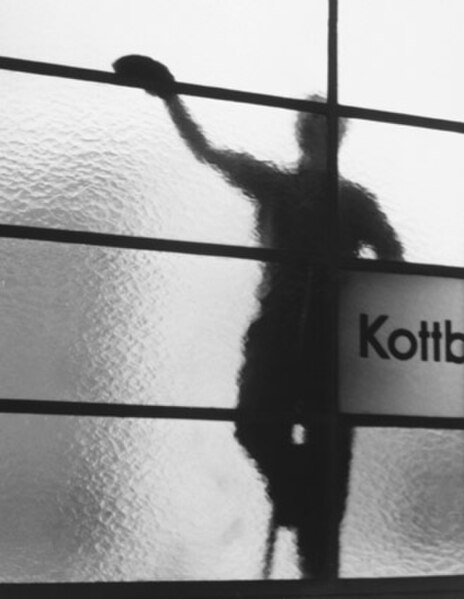Street photography is photography conducted for art or inquiry that features unmediated chance encounters and random incidents within public places, usually with the aim of capturing images at a decisive or poignant moment by careful framing and timing. Although there is a difference between street and candid photography, it is usually subtle with most street photography being candid in nature and some candid photography being classifiable as street photography. Street photography does not necessitate the presence of a street or even the urban environment. Though people usually feature directly, street photography might be absent of people and can be of an object or environment where the image projects a decidedly human character in facsimile or aesthetic.
"Crufts Dog Show 1968" by Tony Ray-Jones
Louis Daguerre: "Boulevard du Temple" (1838 or 1839)
Charles Nègre, waterseller
Window cleaner at Kottbusser Tor, Berlin, by Elsa Thiemann c. 1946
Candid photography is photography captured without creating a posed appearance. This style is also called street photography, spontaneous photography or snap shooting. Professional photographers sometimes shoot candid photos of strangers on the street or in other public places such as parks and beaches. Candid photography captures natural expressions and moments that might not be possible to reproduce in a studio or posed photo shoot. This style of photography is most often used to capture people in their natural state without them noticing the camera. The main focus is on capturing the candid expressions and moments of life. Candid photography can be used in a variety of settings such as family gatherings, special events, and everyday street scenes. It is also a popular choice for wedding photos and professional portraits. Candid photography is often seen as a more honest representation of the subject than posed photography. To capture candid photos, the photographer may need to observe the subject from a distance or use a long lens or telephoto zoom lens. This allows for capturing the subject in their natural environment without them being aware of the camera. The photographer may need to be quick and have an eye for interesting compositions and backgrounds.

A candid photograph, made in Chicago in 1988
Candid photograph by YBA artist Henry Bond
The 35mm Leica camera first introduced in the 1920s is associated with candid photography.
One of a 1908 series of candid photographs by George W. Harris titled The Evolution of a Smile; just after a formal portrait session, William Howard Taft learns by telephone from Theodore Roosevelt that he has been nominated by the Republican Party for the office of President.








